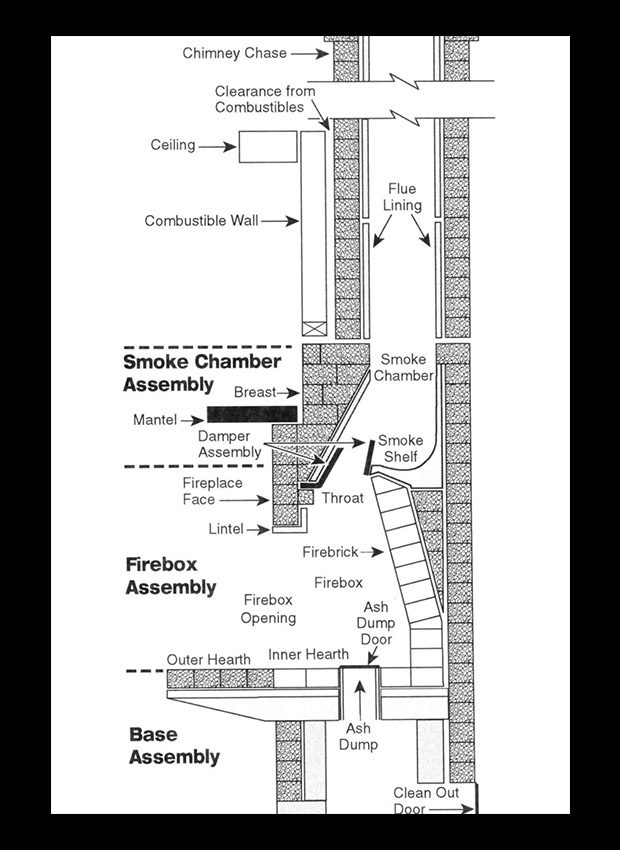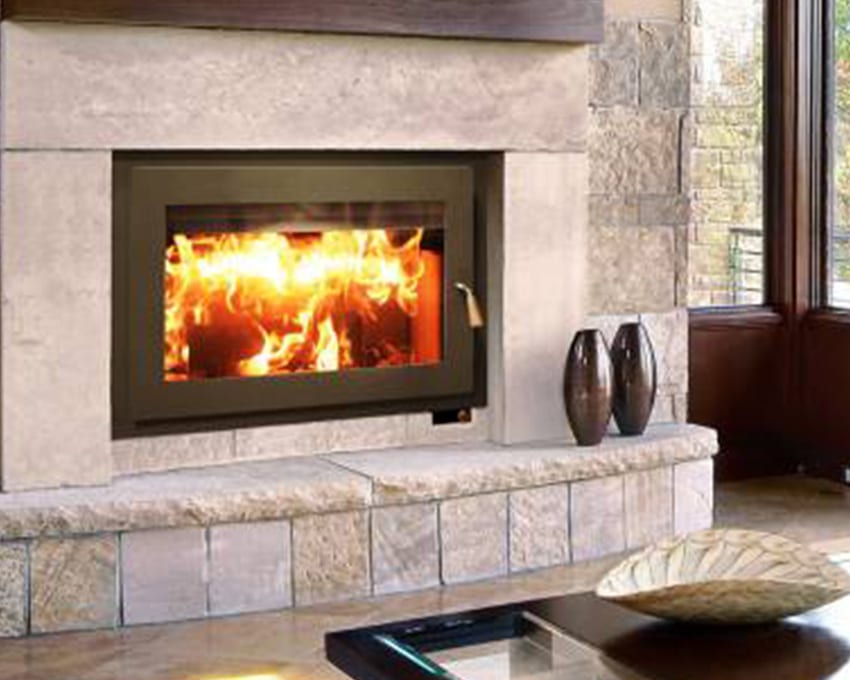A lot of people have no idea that there are different types of fireplaces, and most people don’t know what kind they actually have. This is a the most important piece of information you will need when shopping for fireplace products, or when trying to schedule service. Below we will categorize each type of fireplace and show you how to figure out which one is in your home.
So, there are two basic categories of fireplaces, solid fuel and gas. Solid fuels are things such as wood, coal, pellets, and manufactured goods such as Duraflame logs. Gas fireplaces in the U.S. run on either propane (LPG) or natural gas (NG). Now before I forget you also have gel fueled and electric fireplaces; but odds are, if you have one of these you know it.
Fireplaces and the like can be separated into 8 distinct categories:
- Masonry wood or gas burning
- Prefab/zero clearance/air cooled wood or gas burning
- Direct vent gas
- B-vent/natural vent gas
- Ventfree/ventless gas
- Electric
- Gel/alcohol fueled
- Inserts/Stoves wood, gas, electric, or pellet burning.
Masonry Fireplace
Masonry fireplaces are site built fireplaces composed entirely of brick, stone, and the like. These are the easiest to identify because the brick starts on your floor and continues without interruption all the way to the top of the chimney. The second easiest way tell is to simply look up past the damper. If you see masonry instead of metal pipe; then you have a masonry fireplace. A safe and operational masonry fireplace can be used to burn wood, vented gas logs, vent free gas logs, or an insert.
Prefab/Zero Clearance/ Air Cooled Fireplace
Just to start; these are all the same thing. Depending on the manufacturer or part of the country you are in; these are just different ways to refer to the same thing. For our purposes here we are going to call the prefab fireplaces.
Prefab fireplaces are also fairly easy to identify. Most notably they use a metal pipe for the flue/chimney. Simply by looking up the chimney past the damper (they will always have a damper) you will see a round metal pipe between 8-12” in diameter. You will also see this pipe in your attic in most cases. These fireplaces can also be identified by looking at the firebox itself. Inside a prefab fireplace you will have a ceramic floor panel, and 1-3 ceramic walls that usually have some sort of brick pattern stamped into them.
If your home is older than 1990 you may have two metal side walls, and the back may appear to be 2-4 large brick looking pieces. These panels are called refractory panels and when inspected closely can be easily discerned from brick. Prefab fireplaces can also use a gas log lighter to start wood fires. These fireplaces can burn wood, gas, or inserts. One big notable difference between these and masonry fireplace is most prefab fireplaces are not approved for use with vent free logs with the damper closed.
Direct Vent Gas Fireplace
Direct vent fireplaces are currently the most popular form of gas fireplace. They are highly efficient, and are usually rated as heaters. Direct vent fireplaces are generally operated by wall switch or remote. These appliances will always have a solid and sealed glass panel over the front of the fireplace that does not open. This panel prevents room air from being used in the combustion and exhaust process; which in turn, makes the home and fireplace more efficient. These fireplaces use a double wall or co-axial chimney.
The inner pipe sends exhaust to the exterior, and the outer pipe is used to provide combustion air to the firebox. Direct vent fireplaces will always have a pilot light. This pilot light may be automatic and light itself when the fireplace is turned on, or it may be a “standing” pilot which has to be manually lit. The best way to determine whether or not it’s a direct vent fireplace is by the glass panel. However, some will also have an external (outside the home) exhaust vent that appears on the wall behind or near the fireplace. These fireplaces cannot be altered. The burner, logs, interior, and glass panel cannot be changed.
B-Vent/Natural Vent Gas Fireplace
These fireplaces fall into what professionals refer to as builder grade fireplaces. These are the cheapest and generally least desirable fireplaces. B-vent fireplaces use a single wall type chimney, and they use room air for combustion, and exhaust room air up the chimney. They will usually have a glass door kit or glass panel on the front. The doors are usually operable, and if it has the fixed glass panel it will have a gap at the top, bottom, or both. These fireplaces can usually only be differentiated from a direct vent by a home owner by the lack of a fixed, gasket bearing glass panel.
The logs and flame in these units are usually pretty small and unattractive. B-vent fireplaces are decorative in nature and are not for heat. This type of fireplace will always have a pilot light. This pilot light may be turned on automatically when the unit is turned on, or a “standing” pilot that has to be manually lit. The logs, burner, interior, and glass panels/doors cannot be changed or altered in most cases.
 Vent-free/ Ventless Gas Fireplace
Vent-free/ Ventless Gas Fireplace
The first major distinction to be made in this category is that vent-free are for indoor use, and ventless is for outdoor use only. This is an important clarification that needs to made prior to purchasing one of these units.
Vent-free fireplaces are easy to identify as they have no flue or chimney. These can be built of metal or masonry, but they will never have a chimney. Vent-free appliances are for heat, a lot of it. These are most popular in rural areas where power outages can be frequent and long lasting. Vent-free appliances have a very static appearing flame, and do not look as good as their vented counterparts.
There are more modern versions of vent-free and ventless fireplaces that do not try to emulate a wood fire through the use of logs, but have more contemporary media such as fire glass or stones. Vent-free appliances cannot be installed in air tight homes, or in mobile and manufactured homes. It is also important to note that anyone with breathing difficulties should not be around vent-free appliances when in use.
Electric Fireplace
This is an easy category. Electric fireplaces do not have a real fire. It is a simulated fire using various forms of lighting. These fireplaces can be used almost anywhere, and do not require a chimney.
Gel / Alcohol Fueled Fireplaces
Again, this is an easy category. These fireplaces use a petroleum or alcohol based gel that is poured into a pan or cartridge and then lit. This type of fireplace does not use a chimney, but it may have a clearance to combustibles that should be adhered to. Gel fueled fireplaces don’t always have logs, but rather a decorative bowl, media, or design around which the fire burns. These fireplaces run for 1-4 hours on a single load of fuel. An important note here is they can be very expensive to burn on a consistent and regular basis.
Stoves and Inserts (wood, gas, pellet, electric)
In this section we are not going into too much detail on the specifics. Our goal here is to simply identify the appliance.
Stoves are free standing appliances that sit out in a room or can be built into an alcove.
These appliances are designed for the purpose of heating small to large spaces. They are built to burn only one type of fuel. They can be wood ,gas ,pellet, or electric. They will have some form of a chimney unless it’s electric or vent-free.
Inserts are basically the same thing as stoves, but they are made to fit inside an existing fireplace. These will use a liner that runs up the existing flue unless its electric or vent-free.
If you still need help identifying your specific fireplace you can email a few pictures of it to us at info@elegantfireside.com or call us at (972) 846-4678. You can visit our social media for more details. We also service all of these appliances should you ever need it!

